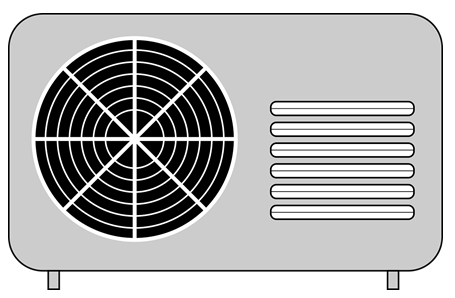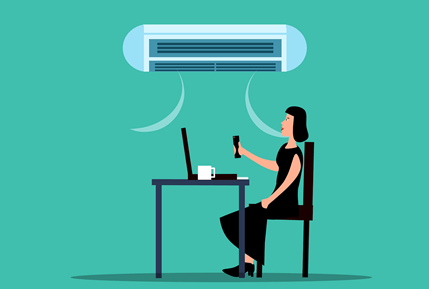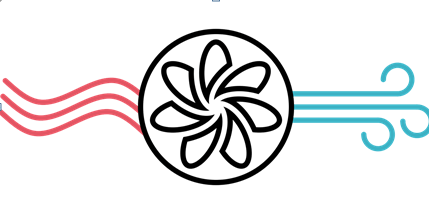Refrigerated Air vs. Evaporative Cooling: A Comparative Analysis

As the climate continues to warm and summer temperatures soar, the demand for effective cooling systems in homes and businesses has never been higher. Among the most common methods for cooling air in residential and commercial spaces are refrigerated air conditioning and evaporative cooling.
Both systems have their own unique advantages and drawbacks, making them suitable for different environments and preferences.
Refrigerated Air Conditioning
Refrigerated air conditioning, often simply referred to as central air conditioning, and uses a closed system to cool air. This system involves refrigerant gases, compressors, and evaporator coils to absorb heat from indoor air and expel it outside, leaving the cooled air to circulate within the building.
One of the main advantages of refrigerated air conditioning is its ability to provide consistent and precise temperature control. Regardless of external weather conditions, this system can maintain a set indoor temperature, offering reliable comfort.
Additionally, refrigerated air conditioning improves indoor air quality by filtering out dust, allergens, and pollutants. Modern systems often come equipped with advanced filters that capture even the smallest particles, providing cleaner air. This is especially beneficial for individuals with allergies or respiratory issues.
However, refrigerated air conditioning comes with its own set of limitations. The initial installation cost can be quite high, especially for central air systems that require ductwork throughout the building.
Maintenance is another consideration. Refrigerated air conditioning systems require regular servicing to ensure optimal performance and longevity. This includes tasks such as cleaning or replacing filters, checking refrigerant levels, and inspecting the overall system for wear and tear.

Evaporative Cooling
Evaporative cooling, also known as swamp cooling, operates on a different principle. It cools air by drawing warm outside air through water-saturated pads. As the air passes through these pads, the water evaporates, absorbing heat and reducing the air temperature, which is then circulated into the living space.
Evaporative cooling has several advantages, particularly in hot, dry climates. One of its most significant benefits is energy efficiency. These systems use considerably less electricity compared to refrigerated air conditioning because they rely primarily on the natural process of evaporation rather than mechanical refrigeration.
Another advantage is the lower installation and maintenance costs. Evaporative coolers are generally simpler systems that do not require extensive ductwork or complex components, making them less expensive to install and maintain.
Additionally, evaporative coolers add moisture to the air, which can be beneficial in arid regions where the air is often uncomfortably dry. This added humidity can improve comfort levels and help prevent issues such as dry skin and respiratory discomfort.
Despite these benefits, evaporative cooling has its drawbacks. The effectiveness of evaporative coolers is highly dependent on the humidity levels in the surrounding environment. In areas with high humidity, these systems become less effective because the air is already saturated with moisture, reducing the rate of evaporation and, consequently, the cooling effect.
Moreover, evaporative coolers can lead to increased humidity indoors, which can be problematic if not managed properly. High indoor humidity can promote the growth of mold and mildew, potentially leading to health issues and structural damage over time.
When comparing refrigerated air conditioning and evaporative cooling, it is essential to consider the specific needs and conditions of the space to be cooled.
Refrigerated air conditioning is suitable for a wide range of climates, including areas with high humidity and extreme heat. You can visit https://www.heat.gov/ to learn more about extreme heat.
On the other hand, evaporative cooling is most effective in hot, dry climates where the low humidity allows for efficient evaporation and cooling. In such environments, evaporative coolers can provide a cost-effective and energy-efficient cooling solution.

Cost and Efficiency
In terms of cost and efficiency, evaporative cooling generally has the edge. The lower initial installation cost and reduced energy consumption make it an attractive option for those looking to save on expenses. However, the efficiency of evaporative coolers can be significantly compromised in humid conditions, limiting their applicability.
Refrigerated air conditioning, while more expensive to install and operate, offers superior performance in a wider range of conditions. The ability to maintain a consistent indoor environment and improve air quality justifies the higher costs for many users.
Maintenance and Environmental Impact
Maintenance requirements differ between the two systems. Refrigerated air conditioning requires more regular and potentially costly maintenance to keep it running efficiently. Evaporative coolers, being simpler systems, generally require less frequent and less expensive maintenance.
From an environmental perspective, evaporative cooling is more eco-friendly due to its lower energy consumption and the absence of harmful refrigerants. However, water usage can be a concern in areas where water is scarce.
Both refrigerated air conditioning and evaporative cooling have their distinct advantages and limitations. Professionals like the ones at First Rate Plumbing Heating and Cooling can help you determine the best option for your home or business. Look at online reviews to help you find a reputable local company.
Refrigerated air conditioning provides precise temperature control, improved air quality, and reliable performance across a range of climates but comes with higher costs and energy consumption. Evaporative cooling offers energy efficiency, cost savings, and added humidity in dry climates but is less effective in humid conditions and provides less precise temperature control.
The choice between the two systems depends largely on the specific climate, budget, and cooling needs of the user. By understanding the strengths and weaknesses of each system, homeowners and businesses can make informed decisions to ensure optimal comfort and efficiency in their cooling solutions.

